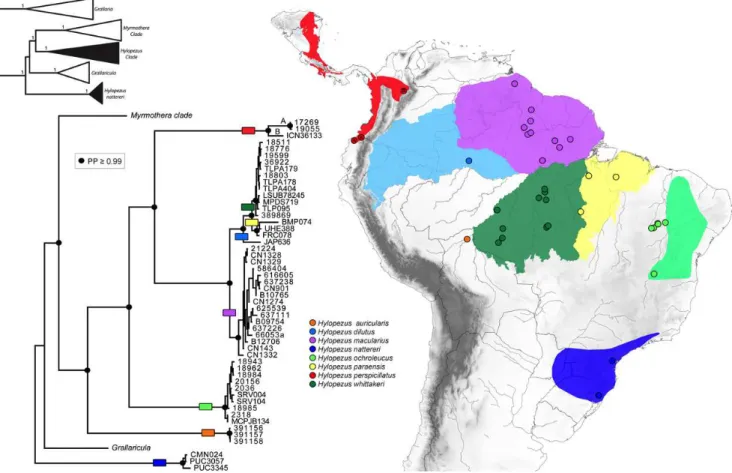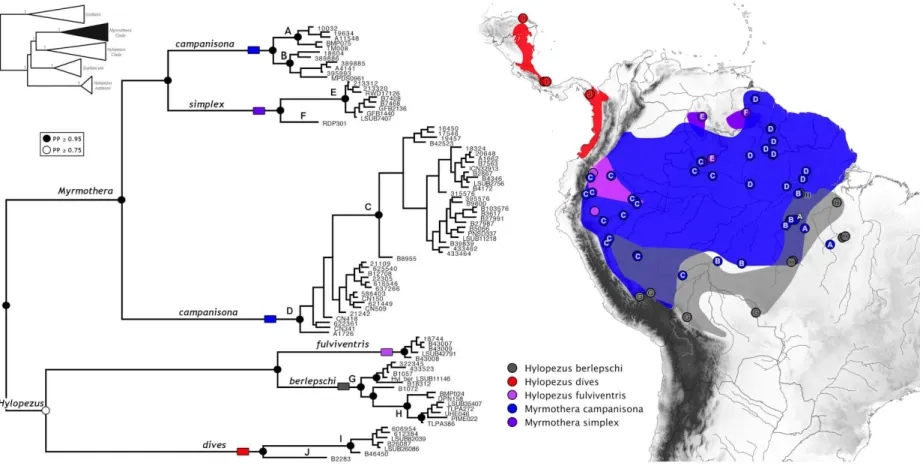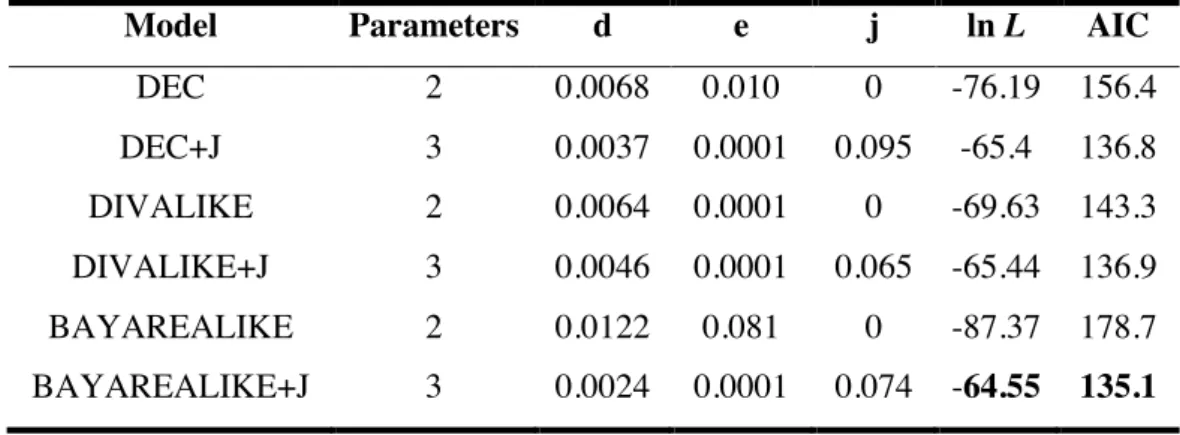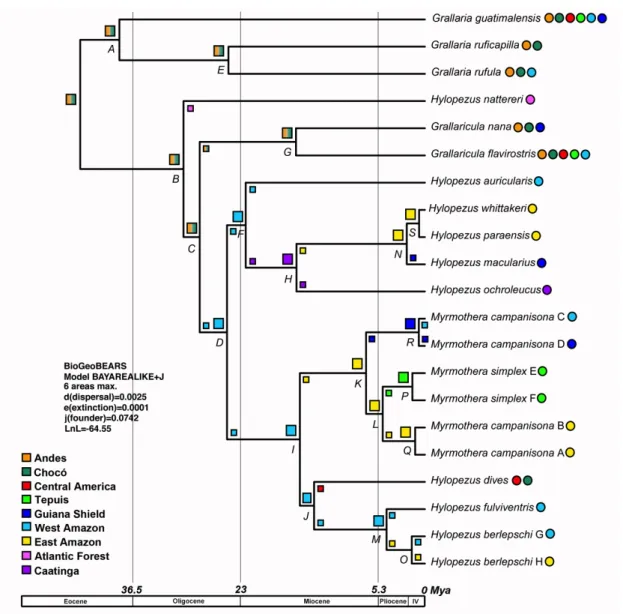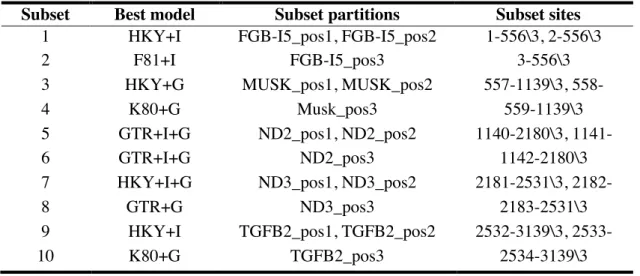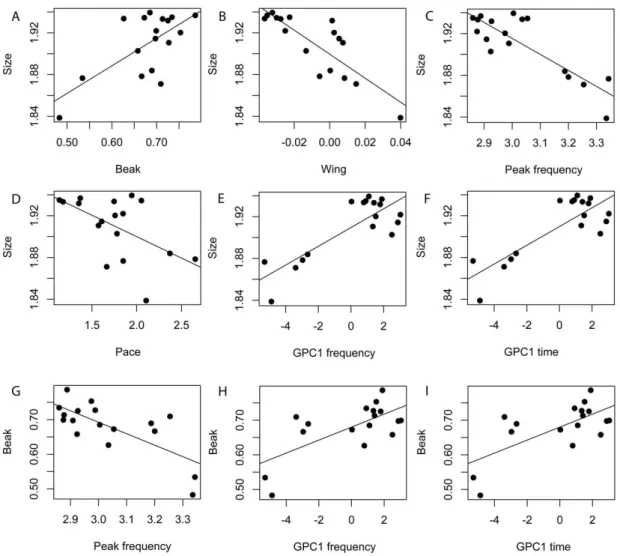Lincoln Silva Carneiro
SISTEMÁTICA E DIVERSIFICAÇÃO DOS
GÊNEROS
H
YLOPEZUS E M
YRMOTHERA
MUSEU PARAENSE EMÍLIO GOELDI
UNIVERSIDADE FEDERAL DO PARÁ
PROGRAMA DE PÓS-GRADUAÇÃO EM ZOOLOGIA
CURSO DE MESTRADO EM ZOOLOGIA
SISTEMÁTICA E DIVERSIFICAÇÃO DOS GÊNEROS H
YLOPEZUS EM
YRMOTHERA(AVES: GRALLARIIDAE)
Aluno: Lincoln Silva Carneiro
Tese apresentada ao Programa de Pós-graduação em Zoologia, Curso de Doutorado, do
Museu Paraense Emílio Goeldi e Universidade Federal do Pará como requisito para
obtenção do grau de doutor em Zoologia.
Orientador: Dr. Alexandre Aleixo
LINCOLN SILVA CARNEIRO
SISTEMÁTICA E DIVERSIFICAÇÃO DOS GÊNEROS H
YLOPEZUS EM
YRMOTHERA(AVES: GRALLARIIDAE)
________________________________________________
Dr. Alexandre Aleixo
Orientador
Departamento de Zoologia, Museu Paraense Emílio Goeldi
________________________________________________
Dra. Teresa Cristina Sauer de Ávila-Pires
Titular
Departamento de Zoologia, Museu Paraense Emílio Goeldi
________________________________________________
Dra. Camila Cherem Ribas
Titular
Instituto Nacional de Pesquisas da Amazônia
________________________________________________
Dr. Pericles Sena do Rêgo
Titular
Universidade Federal do Pará
________________________________________________
Dr. Alexander Charles Lees
Titular
Museu Paraense Emílio Goeldi
________________________________________________
Dr. José de Sousa e Silva Júnior
Suplente
Museu Paraense Emilio Goeldi
________________________________________________
Dra. Sofia Alexandre Marques Silva
Suplente
AGRADECIMENTOS
Gostaria de agradecer a todas pessoas e instituições que contribuíram direta e
indiretamente para que esse trabalho se concretizasse.
Quero agradecer ao Museu Paraense Emílio Goeldi, à Universidade Federal do
Pará e ao programa de pós-graduação. A Capes pelo suporte financeiro durante estes
quatro anos de pesquisas.
A todos os curadores de diversas instituições Nacionais e Internacionais: Natan
Rice (ANSP), John Bates (FMNH), Carla Fontana (PUC), Cristina Miyake (LGEMA),
Ao Field Museum of Natural History (FMNH), na figura do Dr. Jonh Bates; aos Drs.
Paul Sweet e Joel Cracraft, do American Museum of Natural History (AMNH); ao Dr.
Nathan Rice, da Academy of Natural Sciences of Drexel University (ANSP); ao Dr.
Terry Chesser, do National Museum of Natural History (NMNH); à Dra. Cristina
Miyake (LGEMA); à Dra. Carla Fontana, da Pontifícia Universidade Católica do RS
(PUC-RS); ao Dr. Mark Robbins, do Kansas University Natural History Museum
(KUNHM); Donna Ditmann e Robb Brumfield (LSU).
A Terry Chesser e Joel Cracraft por me ajudarem na obtenção de financiamento
que possibilitou a analise das peles depositadas nas principais coleções dos EUA. E por
me receberem em suas respectivas instituições. E aos diversos colaboradores que
gentilmente nos cederam vocalizações e tecidos de todo Neotrópico, em especial ao Dr.
Gustavo Bravo pela parceria neste trabalho e pelas importantes amostras moleculares
que nos cedeu.
agradável. Ao pessoal do laboratório de Biologia Molecular do MPEG, especialmente à
Joice, Cintia e ao meu amigo Geraldo Lima pela ajuda com a bancada.
Um agradecimento Especial ao meu ‘compadre’ Ângelo Dourado, pela amizade,
pelas conversas e apoio nos momentos mais complicados e pelas ajudas com as
coordenadas e com os mapas, valeu mano. À Marcelo Sturaro e Pedro Peloso, pela
amizade e pelas conversas sobre biologia evolutiva e sistemática, que sem duvida,
contribuíram para melhorar as ideias contidas na Tese. Ao Pedro Peloso, também pela
revisão de parte do manuscrito.
À Liza Maria Veiga, in memoriam, pelo incentivo para iniciar nessa maravilhosa e
árdua jornada que foi o doutorado, pela paciência e dedicação, sou muito grato por tudo
que compartilhei com ela.
Agradeço ao meu orientador Alexandre Aleixo, pela oportunidade e pela
confiança que depositou em min. Por ter abraçado esse trabalho sem restrições não
medindo esforços pra garantir as condições necessárias a sua realização. Pelo incentivo,
pela orientação e por todas as construtivas conversas que me fizeram entender melhor a
sistemática e a taxonomia das aves, muito obrigado chefe!
À minha família, que sem dúvida é a razão de tudo: em especial meus pais
Francisco Carneiro e Maria de Fátima e a minha segunda mãe tia Edith que lutaram
muito pra que isso tudo fosse possível, ao meu irmão: Faisal e as maravilhosas
sobrinhas que me deu Duda e Sarah. Quero também agradecer à nova família que
ganhei, Rozilda e Vicente Borges, Amanda e Monike que me acolheram e me apoiaram
muito nessa fase final.
Um agradecimento especialíssimo a minha namorada Mazillene Borges, pelo
carinho, amor, apoio e motivação. Pela compreensão durante os momentos mais críticos
e por todo o suporte que tem me dado, obrigado meu amor!
Sumário
1. Introdução geral ... 1
2. Objetivos ... 5
3. Referências Bibliográficas... 6
4. Capítulo 1 ... 11
5. Capítulo 2 ... 58
Introdução Geral
Os avanços recentes no campo da sistemática de aves, especialmente com a inclusão de
caracteres moleculares e vocais, tem levado a uma melhor compreensão dos processos
históricos que geraram a diversidade de aves do Neotrópico e a um grande número de
rearranjos sistemáticos e taxonômicos (Zink & Blackwell-Rago, 2000; Aleixo, 2002;
D’Horta
et al., 2008; Zimmer, 2008; Navarro-Sigüenza
et al., 2008; Rheindt
et al.,
2008).
Atualmente, existem diversas hipóteses que tentam explicar a diversidade presente e sua
distribuição espacial, entre as principais podemos citar: a Hipótese paleogeográfica
(Emsley, 1965); o modelo das barreiras ripárias (Wallace, 1852; Gascon et al., 2000); a
hipótese dos refúgios (Haffer, 1969; 1997); a hipótese dos rios-refúgios (Ayres, 1992); e
a hipótese de perturbação-vicariância (Colinvaux, 1993). Embora essas varias hipóteses
biogeográficas tenham sido formuladas, apenas poucos estudos têm testado os padrões
filogenéticos dos táxons Neotropicais (Derryberry
et al., 2011; Patel
et al., 2011;
d’Horta
et al., 2012; Ribas,
et al.,
2011; Smith
et al., 2013, Bryson
et al., 2014). E
apesar do grau de complexidade das hipóteses propostas, alguns estudos (Bates
et al.,
1998; Tobias, et al., 2008; Antonelli, et al., 2010) tem proposto que a história evolutiva
da biota neotropical pode ter sido influenciada por um mosaico de diferentes modelos
ao longo do tempo, sugerindo um passado ainda mais complexo do que o previsto pelas
hipóteses existentes.
Táxons proximamente relacionados e que ocupam uma mesma área biogeográfica ou
um mesmo bioma, representam modelos promissores para testar tais hipóteses, uma vez
que permitem a identificação e comparação dos diferentes processos históricos que
levaram a sua diferenciação (Aleixo & Rossetti, 2007; Antonelli,
et al.,
2010). Os
gêneros Hylopezus e Myrmothera, atendem estes requisito, já que alguns de seus táxons
ocorrem amplamente no Neotropico e são simpátricos em algumas áreas (Krabbe &
Schulenberg,
2003; Remsen
et al., 2012), permitindo, assim, uma análise comparativa
dos efeitos dos eventos históricos sobre essas linhagens filogeneticamente próximas e
co-distribuídas.
parafilia deste grupo e realocaram estes dois gêneros na família Grallariidae (Sclater &
Salvin 1873), juntamente com os gêneros Grallaricula e Grallaria (Irestedt et al., 2002;
Chesser et. al, 2004; Rice, 2005a,b). Os gêneros Hylopezus e Myrmothera formam uma
linhagem bem apoiada que tem como grupo irmão o gênero
Grallaricula (Rice,
2005a,b), e esse clado, por sua vez, tem como grupo irmão
Grallaria (Krabbe
et al.,
1999, Irestedt et al., 2002, Chesser et. al, 2004, Rice, 2005 2005a,b).
O gênero
Hylopezus
foi descrito por Ridgway (1909) e distribui-se na região
Neotropical, estendendo-se desde Honduras até o nordeste da Argentina (Krabbe
&Schulenberg 2003). Até recentemente, eram reconhecidas oito espécies biológicas no
gênero, H. macularius, H. perspicillatus, H. fulviventris, H. berlepschi, H. ochroleucus,
H. auricularis, H. nattereri e H. dives (Peters 1976, Ridgely & Tudor, 1994, Krabbe &
Schulenberg,
2003; Remsen et al., 2012). Entretanto, Carneiro et al.,
(2012), com base
em caracteres morfológicos, vocais e moleculares descreveram uma nova espécie,
H.
whittakeri, e elevaram três subespécies do complexo macularius ao nível de espécie (H.
macularius,
H. dilutus,
H. paraensis). Portanto, atualmente o gênero
Hylopezus
comporta 11 espécies e 12 subespécies (Krabbe & Schulenberg, 2003; Carneiro
et al.,
2012), a saber:
•
Hylopezus (m.)Ridgway1909
•
Hylopezus perspicillatus (Lawrence) 1861
•
Hylopezus perspicillatus intermedius
(Ridgway)1884 - Ocorre do leste de
Honduras até o Oeste do Panamá.
•
Hylopezus perspicillatus lizanoi
(Cherrie) 1891 - Distribuido do sul da Costa
Rica até o Oeste do Panamá.
•
Hylopezus perspicillatus pallidior Todd1919 – Colombia, vales do alto rio Sinú.
•
Hylopezus perspicillatus periophthalmicus (Salvadori & Festa)1898 - Ocorre do
oeste da Colombia até o Noroeste do Equador (Chocó).
•
Hylopezus perspicillatus perspicillatus
(Lawrence) 1861 - Distribuido do leste
do Panamá até o Noroeste da Colombia
•
Hylopezus auricularis Gyldenstolpe1941
•
Hylopezus dives (Salvin) 1865
•
Hylopezus dives barbacoae
Chapman 1914 - Ocorre do leste do Panamá até a
costa sul da Colombia.
•
Hylopezus dives dives (Salvin) 1865 - Ocorre do leste de Honduras até o sul da
Costa Rica.
•
Hylopezus dives flammulatus Griscom1928 – Noroeste do Panamá.
•
Hylopezus fulviventris (Sclater, PL)1858
•
Hylopezus fulviventris caquetae
Chapman 1923 – Disrtibuido na região sudeste
da Colombia.
•
Hylopezus fulviventris fulviventris
(Sclater, PL) 1858 – Leste do Equador ao
norte do Peru.
•
Hylopezus berlepschi (Hellmayr)1903
•
Hylopezus berlepschi berlepschi (Hellmayr)1903 – Sul da Amazonia brasileira
do leste do Purús até a margem oeste do Tocantins.
•
Hylopezus berlepschi yessupi
(Carriker) 1930 – Leste do Peru até a margem
oeste do Purús.
•
Hylopezus ochroleucus (Wied-Neuwied)1831
•
Hylopezus nattereri (Pinto) 1937
O gênero Myrmothera foi descrito por Vieillot (1816), e distribui-se exclusivamente na
bacia amazônica (Krabbe & Schulenberg 2003). São atualmente reconhecidas duas
espécies para o gênero,
M. campanisona e M. simplex (Peters, 1976, Ridgely & Tudor,
1994, Krabbe & Schulenberg,
2003 e Remsen et al., 2012), porém ambas são espécies
politípicas e possuem apreciável variação vocal e de plumagem. De acordo com Krabbe
& Schulenberg (2003), este gênero possui atualmente 10 subespécies:
•
Myrmothera (f.) Vieillot 1816
•
Myrmothera campanisona (Hermann) 1783
•
Myrmothera campanisona campanisona (Hermann) 1783: Sudeste da Venezuela
e Guianas.
Venezuela e Noroeste do Brasil.
•
Myrmothera campanisona minor (Taczanowski) 1882: Leste do Peru (Sul do rio
Amazonas), Oeste do Brasil (Leste do rio Purús) e Extremo Noroeste da Bolivia.
•
Myrmothera campanisona modesta (Sclater, PL) 1855: Base leste dos andes da
Colombia (Sul de Meta)
•
Myrmothera campanisona signata Zimmer 1934: Leste do Equador e Nordeste
do peru (Norte do rio Amazonas)
•
Myrmothera campanisona subcanescens Todd 1927: Brasil, Sul do rio
Amazonas, do leste do rio Madeira ao oeste do rio Xingu.
•
Myrmothera simplex (Salvin & Godman) 1884
•
Myrmothera simplex duidae Chapman 1929: Sul da Venezuela (Duida e
Neblina).
•
Myrmothera simplex guaiquinimae Zimmer & Phelps, WH 1946: Sudeste da
Venezuela e Sudeste da Bolivia.
•
Myrmothera simplex pacaraimae Phelps, WH Jr & Dickerman 1980: Sul da
Bolivia, Monte Paracaima.
•
Myrmothera simplex simplex (Salvin & Godman) 1884: Sudeste da Venezuela,
Monte Roraima.
Trabalhos recentes indicam a existência de uma pronunciada variação vocal em vários
complexos de espécies dos gêneros
Hylopezus e
Myrmothera (Maijer 1998, Krabbe &
Schulenberg 2003, Carneiro
et al., 2012), contrastando com o tratamento taxonômico
atual, que é baseado majoritariamente em caracteres morfológicos e de plumagem
(Ridgway 1909; Lowery & O’Neill 1969) que nesses dois gêneros são crípticos e de
difícil diagnose (Cadena et al., 2007, Carneiro et al., 2012). Esses dados evidenciam a
falta de conhecimento das relações filogenéticas entre os táxons desses dois gêneros,
fato que impossibilita a caracterização acurada da história evolutiva a da real
diversidade deste grupo.
fenotípicos destes dois gêneros, no intuito de melhor compreender os processos que
moldaram a diversidade desse grupo na região Neotropical. O uso de dados
morfológicos, moleculares e vocais para a caracterização espacial e temporal da
diversificação dos gêneros
Hylopezus e
Myrmothera permitiu uma compreensão mais
completa dos processos de especiação, biogeografia histórica e fluxo gênico envolvendo
as linhagens destes gêneros, e constitui em ultima analise, um acréscimo ao
conhecimento a cerca dos processos de diversificação da região Neotropical.
2. OBJETIVOS
2.1 – Objetivo Geral
Realizar uma revisão Sistemática e taxonômica dos gêneros
Hylopezus e
Myrmothera,
com base em dados morfológicos, vocais e moleculares, e propor hipóteses sobre a
história evolutiva e biogeográfica desse grupo.
2.2 – Objetivos específicos
•
Verificar a validade dos táxons reconhecidos atualmente para o grupo;
•
Verificar o monofiletismo de
Hylopezus
e Myrmothera como atualmente
compreendidos e buscar as relações entre os táxons desse grupo;
•
Inferir a história evolutiva do grupo e o tempo de divergência entre os clados;
•
Reconstruir as possíveis áreas ancestrais dos táxons desse grupo;
•
Através das topologias obtidas, inferir as relações entre as áreas de ocorrência
das espécies do grupo, na tentativa compreender o relacionamento entre biomas e dentro
deles;
•
Investigar a evolução fenotípica do grupo e contrasta-la com as relações
sistemáticas resgatadas pelas filogenias.
•
Caracterizar os táxons que vierem a ser reconhecidos e analisar sua distribuição
geográfica;
2. Referências Bibliográficas.
ALEIXO, A. 2012. Molecular systematics and the role of “varzea” – “terra-firme”
ecotone in the diversification of
Xiphorhynchus
woodcreepers (Aves:
Dendrocolaptidae). The Auk 119: 621 – 640.
ALEIXO, A. e ROSSETTI, D. F. 2007. Avian gene tree, landscape evolution, and
geology: towards a modern synthesis of Amazonian history biogeography?.
J.
Onithol. 148: 443 – 453.
ANTONELLI, A.; QUIJADA-MASCAREÑAS, A.; CRAWFORD, A. J.; BATES, J.
M.; VELAZCO, P. M; WÜSTER, W. 2010. Molecular studies and
phylogeography of Amazonian tetrapods and their relation to geological and
climatic models. In Amazonia: landscape and species evolution A look into the
past. Blackwell Publishing Ltd. p. 384-405.
BATES, J. M., HACKETT, S. J. & CRACRAFT, J. 1998. Area-relationships in the
Neotropical lowlands: an hypothesis based on raw distributions of passerine birds.
Journal of Biogeography, 25: 783–793.
BRUMFIELD, R. T.; TELLO, J. G.; CHEVIRON, Z. A.; CARLING, M. D.;
CROCHET, N. & ROSENBERG, K. V. 2007. Phylogenetic conservatism and
antiquity of a tropical specialization: Army-ant-following in the typical antbirds
(Thamnophilidae). Mol. Phylogenet. Evol. 45 1-13.
CADENA, C. D., B. LOPEZ-LANUS, J. M. BATES, N. KRABBE, N. H. RICE, F. G.
STILES, J. D. PALACIO, AND P. SALAMAN. 2007. A rare case of interspecific
hybridization in the tracheophone suboscines: Chestnut-naped Antpitta
Grallaria
nuchalis
Chestnut-crowned Antpitta
G. ruficapilla
in a fragmented Andean
landscape. Ibis 10: 1-12.
CARNEIRO,
L.
S, GONZAGA,
L.
P,
RÊGO,
P.
S,
SAMPAIO,
I,
SCHNEIDER,
H.
AND
ALEIXO,
A. 2012. Systematic revision of the spotted antpitta
Hylopezus
macularius (grallariidae), with description of a cryptic new species from brazilian
amazonia. Auk. 129(2): 338 – 351.
CHEVIRON, Z. A.; HACKETT, S. J. & CAPPARELLA, A. P. 2005. Complex
evolutionary history of a Neotropical lowland forest bird (Lepidothrix coronata)
and its implications for historical hypotheses of the origin of Neotropical avian
diversity. Molecular Phylogenetics and Evolution, 36: 338–357.
COLINVAUX, P. 1993. Pleistocene biogeography and diversity in tropical forests of
South America. In
Biological Relationships between Africa and South
America. GOLDBLATT, P. (ed.). New Haven: Yale University Press. p. 99-473.
CRACRAFT, J. 1985. Historical biogeography and patterns of diferention within the
South America avifauna: Areas of endemism.
Ornithological Monographs 36:
49 – 89.
D'HORTA, F. M., SILVA, J.M.C., RIBAS, C. Species limits and hybridization zones in
Icterus cayanensis chysocephalus
group (Aves: Icteridae). Biological Journal of
the Linnean Society 95: 583 – 597. 2008.
DRUMMOND, A.J., RAMBAUT, A. BEAST: Bayesian evolutionary analysis by
sampling trees. BMC Evolutionary Biology 7: 214. 2007.
EMSLEY, M.G. 1965. Speciation in Heliconius (Lep., Nymphalidae): Morphology and
geographic distribution. Zoologica (N.Y.) 50: 191-254.
GASCON, C., MALCOLM, J. R., PATTON, J. L., SILVA, M. N. F., BOGART, J. P.,
LOUGHEED, S. C., PERES, C A, NECKEL, S., BOAG, P. T. 2000. Riverine
barriers and the geographic distribution of Amazonian species. PNAS 97:
13672-13677.
HACKETT, S.J. 1996. Molecular phylogenetics and biogeography of tanagers in the
genus Ramphocelus (Aves). Molecular Phylogenetics and Evolution 5 (2).
368-382.
HAFFER, J. 1985. Avian zoogeography of the neotropical lowland.
Ornithological
Monographs 36: 113-146.
HAFFER, J. 1996. Speciation in Amazonian forest birds. Science 165: 131-137.
IRESTEDT, M., J. FJELDSÅ, U. S. JOHANSSON, AND P. G. P. ERICSON. 2002.
Systematic relations and biogeography of the tracheophone suboscines (Aves:
Passeriformes). Molecular Phylogenetics and Evolution 23: 499-512.
ISLER, M. L., P. R. ISLER, AND B. M. WHITNEY. 1998. Use of vocalizations to
establish species limits in antbirds (Passeriformes: Thamnophilidae).
Auk 115:
577-590.
KRABBE, N Agro, D.J.; Rice, N.H.; Jacome, M.; Navarrete, L. & Sornoza M., F.
(1999): A new species of antpitta (Formicariidae:
Grallaria) from the southern
Ecuadorian Andes. The Auk 116(4): 882-890.
KRABBE, N., AND T. S. SCHULENBERG. 2003. Family Formicariidae
(ground-antbirds). Pag. 682-731 in Handbook of the Birds of the World, Vol. 8. Broadbills
to tapaculos. (J. del Hoyo et al., Eds.). Lynx Edicions, Barcelona.
LOWERY, G. H. J., AND J. P. O´NEILL. 1969. A new species of Grallaria from Peru,
and a revision of the subfamily Grallarinae. Auk 86: 1–12.
MAIJER, S. 1998. Rediscovery of Hylopezus (macularius) auricularis: distinctive song
and habitat indicate species rank. Auk 115:1072-1073.
MARKS, B.D., HACKETT,S.J. e CAPPARELLA, A.P. 2002. Historical relationship
among Neotropical lowland forest areas of endemism as determined by
mitochondrial DNA sequence variation within the Wedge-billed Woodcreeper
(Aves: Dendrocolaptidae:
Glyphorhynchus spirurus).
Molecular Phylog. Evol.
24: 153 – 167.
MCGUIRE, J. A.; WITT, C. C.; ALTSHULER, D. L. & REMSEN JR, J. V. 2007.
Phylogenetic Systematics and Biogeography of Hummingbirds: Bayesian and
Maximum Likelihood Analyses of Partitioned Data and Selection of an
Appropriate Partitioning Strategy. Systematic Biology, 56(5):837–856.
NAVARRO-SIGÜENZA, A. G., A. T. PETERSON, A. NYARI, G. M.
GARCÍA-DERAS, AND J. GARCÍA-MORENO. 2008. Phylogeography of the
Buarremon
brush-finch com- plex (Aves, Emberizidae) in Mesoamerica.
Molecular
Phylogenetics and Evolution 47:21–35.
PETERS, J. L. 1976. Check-list of birds of the world. Vol. VII. Cambridge: Harvard
University Press.
RAIKOW, R.J. 1994. A phylogeny of the woodcreepers (Dendrocolptidae).
The Auk
111 (1): 104 – 114p.
R
emsen
, J. V., J
r
., C. D. C
adena
, A. J
aramillo
, M. N
ores
, J. F. P
acheco
, M. B.
R
obbins
, T. S. S
chulenberg
, F. G. S
tiles
, D. F. S
totz
,
and
K. J. Z
immer
.
2012. [Version: 25 January 2012.] A classification of the bird species of South
America.
American
Ornithologists’
Union.
[Online.]
Available
at
www.museum.lsu. edu/~Remsen/SACCBaseline.html.
RHEINDT, F.E., NORMAM, J.A. e CHRISTIDIS, L. 2008. Genetics differentiation
acroos the Andes in two pan-Neotropical tyrant-flycatcher specie.
Emu 108 (3):
261 – 268.
RIBAS, C.C., ALEIXO, A., NOGUEIRA, A.C.R., MIYAKI, C.Y. & CRACAFT, J.
2011. A palaeobiogeographic model for biotic diversification within Amazonia
over the past three million years.
Proceedings of the Royal Society, Biological
Sciences, 279, 681-689.
RIBAS, C. C. & MIYAKI, C. Y. 2007. Análise comparativa de padrões de
diversificação em quatro gêneros de psitacídeos neotropicais.
Revista Brasileira
de Ornitologia, 15: 245-252.
RICE, N.H.
2005. Phylogenetic relationships of antpitta genera (Passeriformes:
Formicariidae). The Auk 122: 673–683.
RICE, N.H. 2005. Further evidence for paraphyly of the Formicariidae (Passeriformes).
The Condor 107:910–915.
RIDGELY, R.S. e TUDOR, G. The birds of South America: the oscines passerines.
Univ. Texas Press. 516p. 1994.
RIDGWAY, R. 1909. New genera, species and subspecies of Formicariidae,
Furnariidae, and Dendrocolaptidae. Proc. Biol. Soc. Washington, 22: 69-74.
SANMARTÍN, I., MARK, P.V.D. & RONQUIST, F. 2008. Inferring dispersal: a
SILVA, J.M.C., SOUSA, M.C. & CASTELLETTI, C.H.M. 2004. Areas of endemism
for passerine birds in the Atlantic forest, South America.
Global
Ecology and
Biogeography, 13, 85-92.
SLADE, R. W.; MORITZ, C.; HEIDEMAN, A. & HALE, P. T. 1993. Rapid assessment
of single-copy nuclear DNA variation in diverse species.
Molecular Ecology, 2:
359-373.
TOBIAS, J.A., BATES, J.M., HACKETT, S.J., SEDDON, N. 2008. Comment on the
latitudinal gradient in recent speciation and extinction rates of birds and
mammals. Science 319, 901c.
TOBIAS, J.A.; SEDDON, N.; SPOTTISWOODE, C. N; PILGRIM, J, D; FISHPOOL,
L. D. C;.COLLAR, N. J. 2010. Quantitative criteria for species delimitation.
Ibis
12: 1-23.
WALLACE, A. R. 1852. On the monkeys of the Amazon.
Proceedings of the
Zoological Society of London, 20: 107-110.
WILLIS, E. O. 1967. Behavior of Bicolored Antbirds. University of California
Publications in Zoology 79: 1–132.
ZIMMER, K. J. 2008. The White-eyed foliage gleaner (Furnariidade: Automolus) is two
species. The Wilson Journal of Ornithology 120 (1): 10-25.
Capítulo 1
Sistemática molecular e biogeografia historica de duas linhagens
de ‘antpittas’ (Aves, Grallaridae) no Neotrópico
“Molecular systematics and historical biogeography of two
lineages of antpittas (Aves, Grallariidae) across the Neotropics
1”
1
Molecular systematics and historical biogeography of two
lineages of antpittas (Aves, Grallariidae) across the Neotropics
Lincoln Carneiro,1,4 Gustavo Bravo,2 and Alexandre Aleixo3
1Curso de Pós-Graduação de Zoologia, Universidade Federal do Pará–Museu Paraense Emílio Goeldi, Belém, Pará, Brazil; 2 Secção de Aves, Museu de Zoologia, Universidade de São Paulo (MZUSP), Caixa Postal 42.494, CEP 04218–970, São Paulo, SP, Brasil; and 3
Coordenação de Zoologia, Museu Paraense Emílio Goeldi, Caixa Postal 399, CEP 66040-170, Belém, Pará, Brazil.
4Address correspondence to this author. E-mail: lincoln_carneiro@yahoo.com.br
